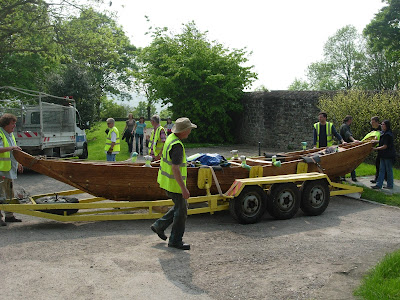A Town Unearthed (aka Flowerbeds)
We're still planning our season of Test pits but things are progressing and we should *hopefully* be starting in the next few weeks. We are focusing our efforts on the East Cliff area to try and establish the size of the Roman and Iron Age site but there is potential to do some work up on the Bayle as recent investigations have uncovered possible evidence for the medieval Bailey Castle, the location of which has been subject to much debate over the years. I'm currently putting the finishing touches on a handbook to give to the volunteers on how to excavate a test pit and fill in the associated paperwork (archaeology isn't all about digging!).
CSI: Sittingbourne (aka Beads)
Is still in the back of my mind although I have been plenty busy with the boat to go and help of late. Next week is looking a bit empty so I will try to go over before A Town Unearthed eats up my time.
Northfleet Harbour Restoration Project
I've been up to have another meeting with the Chairman of the Trust about how to proceed. There is a lot of work to be done to secure the site and improve access before opening this project up to the wider community, but things are progressing and maybe we'll get cracking with the main excavation work in the next few months. They have been doing a little bit of exploring on the slipway and have uncovered 3 phases of tipping which happened in the 20th century; maybe not exciting to some people but I'm interested. They've uncovered leather shoes from the 1920s, coins from the 1940s, bits of old motorbike, early 20th century cosmetic bottles, and glass lampshades from the demolition of a row of houses which once overlooked the site.
Council for British Archaeology paperwork and NVQ stuff
As this is a training placement I have to complete some paperwork to prove I'm learning things! I'll be also working towards getting an NVQ in Archaeological Practice which is part of the training scheme. Getting a job in archaeology can be difficult as there is a lot of competition for very few positions, especially of late with the economic downturn and the halting of a lot of development projects. Most (not all, don't shout at me!) archaeologists go to university and get degrees, MA's and PHD's but find that securing a practical job in archaeology hard because they don't have any experience in excavation. The way most of us have got round this in the past is to volunteer on community excavations and get some experience (rule of thumb is about 6 months before the commercial units will consider hiring you). The NVQ is designed to show employers that you have experience in practical archaeology and are therefore competent on site. I'm on the fence about this but maybe this debate is for another post at a later date.
Kent County Council
The wonderful thing about this placement is that I'm not constricted to working just for CAT so can go off and get involved with external projects. Kent County Council have a strong community archaeology presence and the county community archaeologist, Andrew Mayfield, has a number of projects centred around Shorne Woods in June and July (http://www.kent.gov.uk/leisure_and_culture/heritage/getting_involved/community_archaeology.aspx). More information to follow but June will be test pitting a Mesolithic site and July is the on going excavation of Randell Manor.
Other projects and ideas
- Westgate Parks for People. I've got a minor role in helping to set up the bid for this project, due to start 2014 if funding applications are successful. Part of the Parks for people scheme running across the country (http://www.hlf.org.uk/HowToApply/programmes/Pages/parksforpeople.aspx) aimed at regenerating neglected parks with ecological and heritage benefits.
- Institute for Field Archaeologists. I've been asked by a friend to write an article on community archaeology for the Digger's Forum newsletter. I'm not sure what to write it on yet but it'll probably be centred around the benefits of community archaeology to archaeology as a whole. Some archaeologists don't like community engagement and don't see the point in it, but again this is a debate for another post.
- Operation Nightingale is still in the back of my mind. If you can't remember what Operation Nightingale is, it's the scheme run by the army to rehabilitate injured soldiers coming back from the front lines (mostly from Afghanistan). I'm hoping to be involved in the set-up of something for the regiments in Kent.
- Kent Archaeological Society, Maidstone Museum and the CBA Festival of Archaeology. This is a joint project between CAT and KAS hosted at Maidstone Museum for the Festival of British Archaeology between the 14th and 29th July (http://festival.britarch.ac.uk/). We're coming together to set up a display of our community projects, our volunteering opportunities, and our educational services so I get to help arrange that.
...to be continued...














































